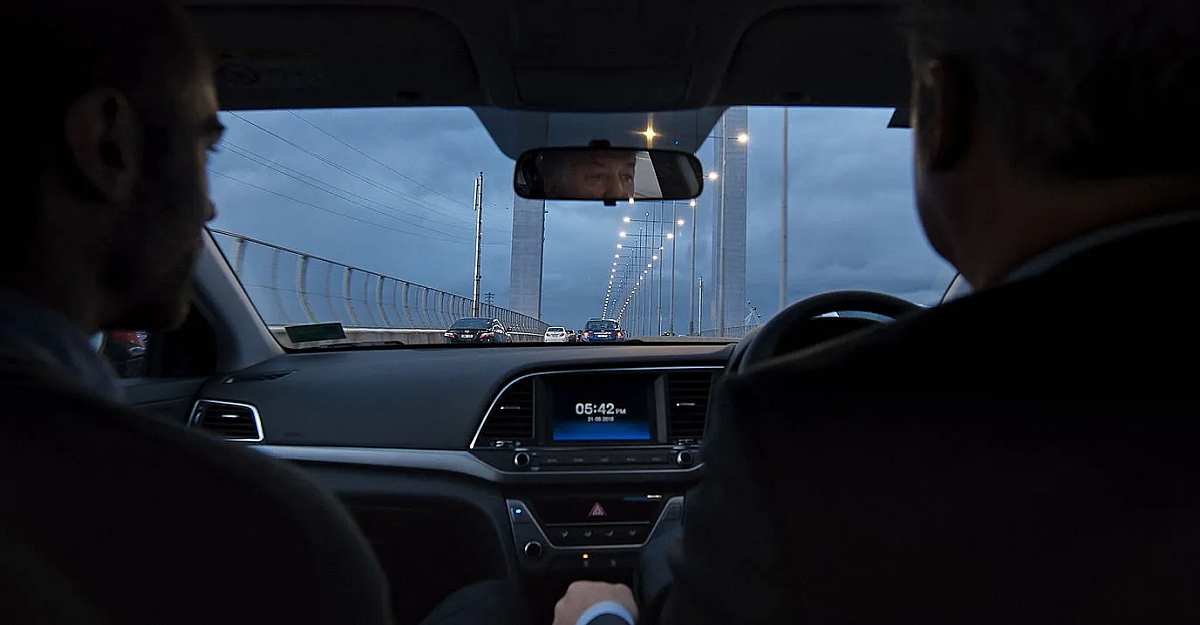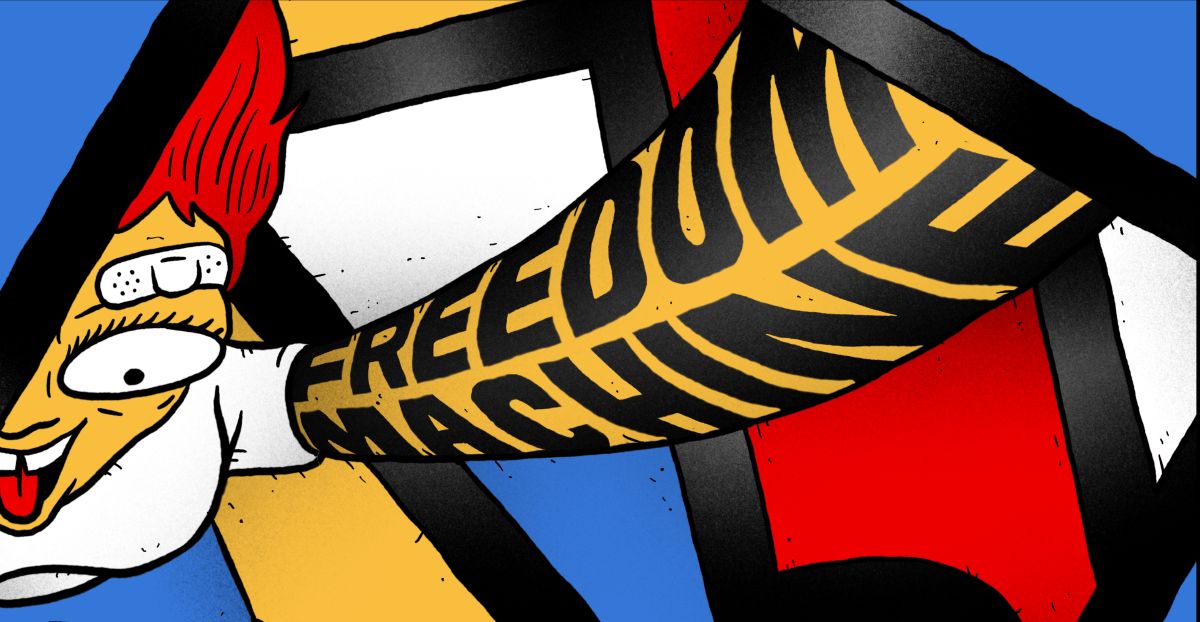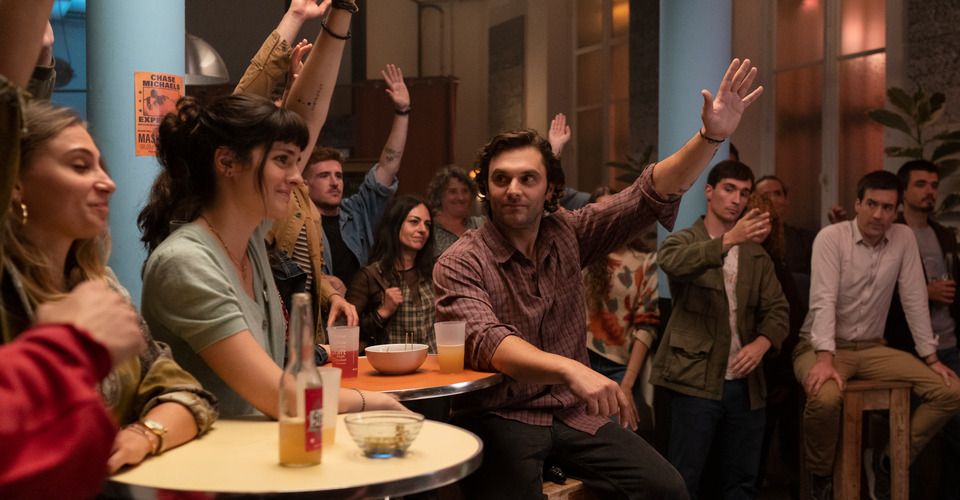On a recent evening I accompanied my housemate to Frankston to pick up her new car, a hot pink Suzuki Alto. The owner was home late — he commutes from near the airport, and the Monash had been choked to a crawl. It was my job to drive the Alto back home.
I hadn’t driven for years, and the inside of the car now felt alien to me, a tin box rattling in space. As the darkness rushed past I began to feel something akin to a death drive. Without directions I became lost and was pulled, inexorably, onto the Monash myself, and in its mammoth twists and turns became totally placeless, the city suspended both above and below me, completely out of reach. When I emerged onto solid ground and saw houses and trees and traffic lights, it felt as if I’d been through a wormhole.
What I’m describing, minus my histrionics, is of course an extremely normal drive, enjoyable for many (and for me, at other times). The recent, semi-experimental independent film The Plains (2022) follows middle-aged man Andrew on his daily afternoon commute, driving west along the same road, towards the setting sun. Each day he calls his wife, and usually his mother, who has dementia. He gives lifts home to a coworker (played by David Easteal, the film’s director) and chats gregariously to him about his life. These commutes all take place within the same unbroken shot (taken from the back seat) and add up to a generous three-hour runtime.
In its repetitions, the film becomes about the commute itself, and all the liminal stretches we spend maintaining our day-to-day rituals, etching out grooves in time, making the same polite conversation. Through observing Andrew’s smallest moments, we can eventually draw in our minds the image of one man’s life.
While the film proceeds slowly, the cumulative effect is utterly enthralling — even thrilling in its minuteness. The real-time, real-world footage seen through the front windshield lends an uncanny documentary feel to the drama, and offers improvised moments of fascinating contrast. At one point Andrew muses that we live in ‘an anxious world,’ and I suddenly notice the electrical pylons looming over the landscape. When the more reticent David opens up about a recent break-up, a truck floats by outside emblazoned ‘COPE – Sensitive Freight’.
The Plains charts the psychic terrain of the freeway in miniature, peeling back the lid of the private vehicle to expose just one of the millions of dramas taking place in simultaneity, severed from one another yet still part of the same city-wide traffic ballet. The image brings to mind Playtime, in which Jacques Tati re-envisions a peak-hour Paris roundabout as a psychedelic carousel. The film presents its own dizzying visual metaphor: breaking from the commute, we see footage from Andrew’s drone camera as it soars high above Victoria’s near-empty flatlands, and both the driver and his car are rendered insignificant.
The Plains fits into the ethos of what is often called ‘slow cinema’, a contemplative approach at odds with the stereotypically fried attention span of today’s audiences. Perhaps this contrast with the zeitgeist is why the genre has been enjoying a resurgence as of late. Jeanne Dielman, 23 Commerce Quay, 1080 Brussels, which methodically observes a Belgian housewife in similarly long moments, recently topped Sight & Sound’s poll of the all-time greatest films — though you may struggle to find non-cinephiles who have heard of it. Directors like Apichatpong Weerasethakul, Lav Diaz and Tsai Ming-liang are exploring the meditative limits of narrative cinema, to rapturous effect. In films like Close-Up, Abbas Kiarostami used a slow docufiction style similar to Easteal, and his Taste of Cherry is also set almost entirely in a car. Director Panah Panahi, whose father Jafar Panahi made films illicitly while under house arrest, says that the notable presence of cars in Iranian cinema is not
an artistic choice, it’s just how we live … inside your car, they won’t bother you if you listen to music or if your scarf falls down.
Like these films, The Plains invites viewers to settle in and draw their own conclusions, ‘no longer a consumer but a producer of the text,’ as Barthes urged readers of literature. This carries a pleasant irony, given that we’re literally sitting in the back seat the whole time.
*
My brain still thrumming with digitised climate anxiety, at times watching the slowness of traffic onscreen reminded me of a quote from J.G. Ballard’s seminal (in both senses) novel Crash:
The enormous energy of the twentieth century, enough to drive the planet into a new orbit around a happier star, was being expended to maintain this immense motionless pause.
In the ’70s, amid the increasing dominance of car-dependent infrastructure and the oil crisis, Ballard saw we were far too psychologically entwined with our vehicles to give them up easily — his introduction states that he uses the car ‘not only as a sexual image, but as a total metaphor for man’s life in today’s society.’ In the novel, every part of the car is sensualised, down to the chrome and leather finishings, and characters are so alienated and stunted that they only feel alive in fetishistic acts of vehicular trauma.
Ballard’s subsequent novel Concrete Island reimagined London’s newly-built Westway (itself on the frontier of inner-city freeway construction, and protested heavily) as the locale for a modern-day Robinson Crusoe — a white-collar professional who becomes trapped in the wasteland between elevated roadways, unable to escape. In this anti-human environment, truck tyres and metal drums become an impenetrable ‘jungle of refuse’, the strip’s embankments and wire fences as much a wilderness as the Atlantic Ocean. When our Crusoe looks down on his island, he sees ‘the outlines of building foundations’ where the city was demolished.
Ballard’s merging of the sensual and natural with the automotive was prophetic. You can see it in the current outgrowth of tank-like, security-obsessed SUVs (how many times can you joke about a Ram overcompensating for something?), and in digitally-integrated cars that harvest your data to create personally-catered advertising experiences.
Our cars are more than transport: they carry their own perspective, which becomes melded with our own. As a child, I took the train to school but was driven most everywhere else. An abstract collage would flow past my window and I would emerge, bewildered, at a destination across the city, with no idea where I was or how I got there. A study found that children living in car-dependent neighbourhoods ‘frequently expressed feelings of dislike and danger and were unable to represent any detail of the surrounding environment,’ as opposed to those who could easily walk or bike.
Crash is set in London, its movie adaptation filmed in Toronto, and applies equally to Melbourne — this car-dependent dystopia is globalised and uniform. The car is a kind of alien colonist, parasitic and totalising, infiltrating and uprooting cities in order to install its own colossal infrastructure like the red weed from The War of the Worlds, sucking out life through bitumen veins, engineering the atmosphere with its fumes. Empty highways have become shorthand in portraying the apocalypse (think The Road or 28 Days Later) — it can feel strange to think that this is a happy outcome.
Australian local councils were initially created to fund roads, and have now become battlegrounds for those wanting to claw them back. Car-dependency is transformative, both politically and psychologically, and outer suburbs have become hubs for reaction and conspiratorialist thinking (just look at the reaction to innocuous ‘15 minute city’ urban planning). A term, motonormativity, has been coined for this type of car-brain, and the resulting unconscious biases around planning. Just as Thatcher’s famous declaration erased the fact that there are, in fact, alternatives, motonormativity erases the history of cars as a post-war political project, entrenching itself in the language of mythos. The seemingly radical individualist freedom offered by a car is dependent on a society that permits and subsidises it.
In Australia, the car became synonymous with Holden and the Australian Dream — never mind that Holden was owned by the US giant General Motors, and the brand was used as a corporate-imperial outpost to spread American-style car-dependency. This Fordist design involved promoting workers as consumers, high wages, low unemployment, and a patriarchal emphasis on suburban home ownership.
Driving is ease, ownership, privacy, the open road. The Australian explosion of car culture (without adequate safety provisions) led to skyrocketing rates of injury and death from motor vehicles in the ’60s and ’70s. This environment inspired Mad Max and was thus at least partly responsible for the Australian New Wave (as in Ballard, crashes create art).
On the day I write this, a horrific act of vehicular homicide occurred on Bourke Street in the CBD. Though uniquely shocking, it shares a commonality with the 1100 other motor vehicle deaths that will occur in Australia this year. Accidental or not, they were caused by cars. Is it not strange we force millions of stressed-out, overworked commuters to drive at sickening speed each day? Meanwhile, construction on the West Gate Tunnel (read: bridge) lumbers on. Neoliberalism gutted the Fordist model, climate change sounded the car’s alarm, and Holden’s retirement in 2021 perhaps marked the official close of the era. But the new world struggles to be born; now is the time of Teslas.
The reason I find The Plains so refreshing is that it takes this world on its own terms. It acknowledges all the dizzying implications of our freeways without falling into Ballard’s high-strung delirium or else reinforcing our decaying norms. Andrew makes an easy stand-in for the Australian Dream: a happy-go-lucky boomer in a rumpled suit, with a home in the suburbs and a holiday cottage on a farm. He enjoys the freedom that driving offers. But it’s clear that even he is struggling, especially when his view is tempered by David’s millennial pessimism. Through simply and steadily observing his commute, Easteal shows how sad and liberating and alienating and plain strange the drive can be, turning the quotidian Dream dreamlike and allowing us to concentrate, and envision the whole scope of its world.
The Plains also offers a striking alternative for Australian film, amid the supposed death of cinema and the generally commercially-minded approach of our funding bodies. Filmmaking technology is cheaper than ever, and other recent Australian films — like the also-great Friends and Strangers — have used tiny budgets to boldly frame the present moment (spurring a ‘mumblecore’ revival). It was encouraging to see that film run at ACMI, but a grassroots cinema culture outside of institutions is also necessary to carry water for such a movement, and especially so for a film as small-scale and formally audacious as The Plains. That these films had to be self-financed also presents another obvious barrier.
Though it’s currently streaming on MUBI, I worry the film will lose something amid the distractions of home viewing (I managed to catch a one-off specialty screening with just a handful of people). Films like this are a lifeline, something unshakably solid that can pull us out of the neuroticism and glitchy freneticism of the smartphone and into the shared, quiet darkness of a theatre. I hope that our cinema can rise to its challenge.



